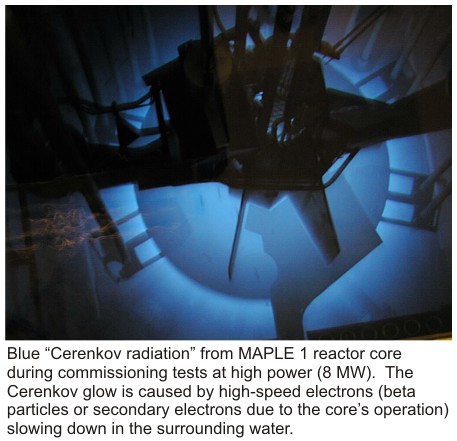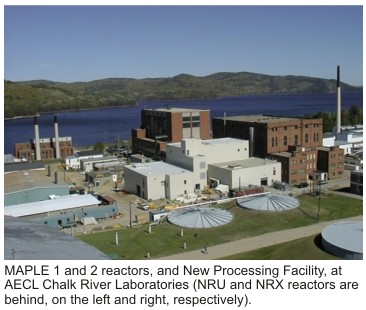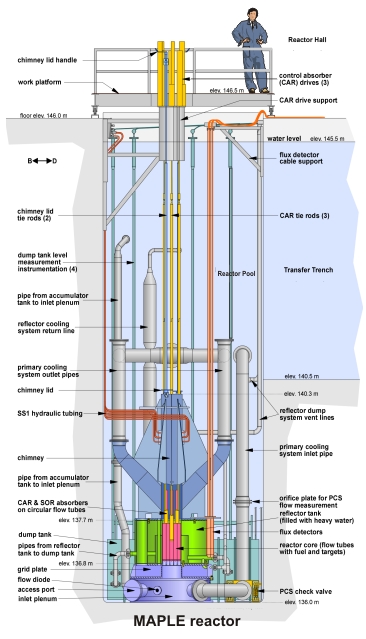The world’s civilian nuclear reactors can be divided into two broad categories: research reactors and power reactors. All of them involve the fission, or splitting, of heavy atoms like uranium and plutonium, and the release of energy (see related FAQ) – but the way this energy is utilized is very different in the two categories of reactors.
Research reactors were the first nuclear reactors built, starting with Enrico Fermi’s “Chicago Pile 1” (CP-1) in 1942, assembled in a squash court at the University of Chicago as a secretive initial operation of the U.S. Manhattan Project to develop an atomic bomb. Fermi’s reactor was more than a wartime project however; it was also a monumental scientific achievement: the first ‘sustained’ demonstration of a new form of energy (nuclear fission), which had been discovered four years earlier in the lead-up to WWII (see related editorial).
There are many uses of nuclear reactors, but the one that most people are familiar with is the generation of electricity; i.e., using the energy of the nuclear fission chain reaction to create heat in a fluid that is then used to turn a turbine connected to an electrical generator. These are called nuclear power reactors, first appearing in 1954, a dozen years after the first research reactors. As of 2020 there were 443 power reactors operating in 34 countries around the world (19 of these power reactors are located in Canada – 18 in Ontario and 1 in New Brunswick). Power reactors can also have other industrial uses, such as district heating, sea water desalination, and hydrogen generation.
Broadly speaking, ‘research reactor’ is a term used to describe all the non-power civilian nuclear reactors. As of 2020 there were 223 research reactors operating in 53 countries around the world (four of these are located in Canada – one each at École Polytechnique in Montreal, Royal Military College in Kingston, McMaster University in Hamilton, and Chalk River Laboratories near Ottawa). In total over 840 research reactors have been built around the world since the discovery of fission.
In comparison to power reactors, research reactors tend to be (but are not always) smaller in size and energy generation, are not operated for commercial purposes, and have a much wider scope of designs and applications. While power reactors involve large pressure vessels and high temperatures (>100 deg.C), research reactors are often unpressurized and use much lower temperatures (<100 deg.C).
The fuel for research reactors can use enrichment levels (fraction of the fissile U-235 nuclide, normally 0.7% in nature) up to >90% ‘high-enriched’ uranium (HEU), but more commonly these levels have been capped at 20%, the upper level for ‘low-enriched’ uranium (LEU).
The dimensions of a research reactor can range from objects no larger than a garbage can, to large machines several metres across. Energy output can range from almost nothing, to hundreds of millions of watts of heat.
The first research reactors were developed in parallel with the development of reactor technology itself, and so the “research” in this sense was very much a reference to the R&D needed to fully understand this new area of science and engineering.
Today research reactors have a variety of roles, which can be broadly broken down as (a) material studies, (b) radioisotope R&D and production, (c) nuclear fuel development, and (d) education and training (many research reactors operate on university campuses). One of the very first uses of a research reactor was the creation of the radioisotope cobalt-60 in the NRX reactor at Chalk River Laboratories, for use in the world’s first cobalt cancer therapy machines in 1951. The first category of “material studies” includes both high-energy in-reactor testing of materials, and low-energy out-of-reactor material research using beams of neutrons (see related FAQ). Canada’s Bertram Brockhouse won the 1994 Nobel Prize in Physics for his pioneering work in this area at Chalk River Laboratories.
Related FAQs...
There are currently four operating research reactors in Canada: one at
Chalk River Laboratories and three at universities. The Chalk River
reactor is the zero-energy test reactor, ZED-2. The
university reactors include two 20 kWth SLOWPOKE-2 reactors (at the Royal
Military College
(Kingston), and L'Ecole Polytechnique
(Montreal)), and a 5 MWth MTR-type reactor at McMaster
University. (A Canadian-supplied SLOWPOKE-2 is also operated at the International Centre for Environmental and Nuclear Sciences, Kingston,
Jamaica)
Eight research reactors in Canada have been shut down or fully decommissioned: three at Chalk River Laboratories (NRX, NRU, and PTR), and five SLOWPOKE-2 reactors - the original prototype at the University of
Toronto, plus the SLOWPOKE-2 reactors at MDS Nordion's facility in Kanata, Dalhousie University (Halifax),
University of Alberta (Edmonton), and the Saskatchewan Research
Council (Saskatoon).
The SLOWPOKE-2 is a low-energy, pool-type research reactor designed by
AECL. It uses passive cooling and safety systems, and is licensed to run
unattended for short periods of time (e.g.. overnight). AECL also designed
a scaled-up version (2-10 MWth) of SLOWPOKE for district heating. See
related FAQ.
A more recent research-reactor technology developed by AECL was called
MAPLE (see related FAQ).
Related FAQs...
Images...
One of the most common uses of a "research reactor" is to extract beams of
neutrons from the fission process, and use them in both scientific and
engineering applications in a laboratory adjacent to the reactor. As a
research tool, the two main attractions of neutrons are their neutral
charge, which allows them to penetrate dense objects, and their quantum
wavelength, which is comparable to the lattice spacing in crystals. The
combination allows the use neutron beams as a powerful "microscope", with
which we can peer into an object without damaging it, measure the spacing
of atoms, locate defects, and characterize the motion of atoms in their
bound state.
Neutron-beam materials research in Canada dates from the beginnings of its
nuclear industry. AECL Chalk River Laboratories' NRX reactor, Canada's
first research reactor (1947) was designed with many horizontal beam tubes
radiating out into the surrounding experimental area. The same was true
of NRU, commissioned alongside NRX in 1957 and shut down in 2018. Dr. Bertram Brockhouse won the 1994 Nobel Prize in
physics for his pioneering work in neutron-scattering, performed four
decades earlier at Chalk River Laboratories.
Dr. Brockhouse's legacy is alive today in many solid-state research
programs at universities throughout Canada.
Related FAQs...


|
|

|
|
|
MAPLE (Multipurpose Applied Physics
Lattice Experiment) is a research-reactor
technology developed by AECL, capable of fuels and materials testing,
isotope production, and neutron experimentation (see related
FAQ). The MAPLE concept features a 19.75% U235 enriched, H2O-cooled and D2O-reflected
core, and operates with a thermal power of 5 to 40 MWth. It offers a high
thermal neutron flux, small core volume, and accommodation for multiple
beam-tubes and in-core experimental sites, as well as driven
spectrum-specific facilities in the reflector (cold-neutron source,
fast-neutron flux trap, etc.).
HANARO, South Korea's research reactor which reached first-critical on February 8, 1995, is based upon Canadian MAPLE reactor core technology (see the HANARO Web Site
for more information).
AECL constructed two 10 MWth MAPLE reactors at Chalk River Laboratories (see photos and diagram), which AECL had planned to own and operate on behalf of MDS Nordion, a global radiopharmaceutical supplier.
MMIR-1 (or "MAPLE 1"), the first of these two new MAPLE medical isotope production reactors, was
declared "critical" (began a self-sustaining chain reaction) at 2:53 a.m.
on Saturday, February 19, 2000 at Chalk River Laboratories, becoming the
world's first reactor of the new millenium. Achieving criticality is an
important milestone on the road to full commissioning. (See also a
related editorial by the author.) MMIR-2 ("MAPLE 2") achieved first criticality at 2:08 p.m. on October 9, 2003.
The two reactors would have replaced most of the commercial isotope-production capability of AECL's NRU reactor. By 2008 commissioning excercises had taken the MAPLE 1 core to high power (8 MWth) and successfully tested many of the systems, including the safety shutdown system under conditions such as loss of power regulation. However, several first-of-a-kind technical issues significantly delayed the commissioning process, including regulatory concern over the power coefficient of the MAPLE core (discovered during commissioning to be small but positive). A series of tests were initiated to determine the cause of the positive power coefficient.
On Friday, May 16, 2008, AECL announced that it had halted the development of the two MAPLE reactors at Chalk river Laboratories, citing future costs, risks, and changing market conditions beyond AECL's control. Instead, medical radioisotope production at AECL would continue for the forseeable future to utilize the NRU reactor at Chalk River Laboratories, and development resources would be focussed on both extending the life of that facility, and developing a mutually satisfactory plan with AECL's main medical radiosisotope custormer, MDS Nordion.

Related FAQs...
|


|
The Canadian Institute for Neutron Scattering (CINS) is a not-for-profit, voluntary organization that represents the Canadian scientific community of neutron beam users and promotes scientific research using neutron beams.
Related FAQs...

|
|
SLOWPOKE is an acronym for Safe Low-Power Kritical
Experiment (the "K" is justified! -- it is the
traditional symbol for "criticality" in the field of reactor physics).
SLOWPOKE represents a low-power, compact-core reactor technology developed
by AECL in the late 1960's. There are four SLOWPOKE-2 reactors
operating in Canadian universities (see related FAQ),
rated at 20 kW and supporting nuclear education and/or neutron research.
The SLOWPOKE-2 core is only about 22 cm diameter by 22 cm high, and sits
in a pool of regular ("light") water, 2.5 m diameter by 6 m deep, which
provides cooling via natural convection. In addition to passive cooling,
the reactor has a high degree of "inherent safety"; that is, it can
regulate itself through passive, natural means, such as the chain reaction
slowing down if the water heats up or forms bubbles. These
characteristics are so dominant, in fact, that the SLOWPOKE-2 reactor is
licensed to operate unattended overnight (but monitored remotely).
In the early 1980's AECL developed a higher-power variant of this
technology, called SLOWPOKE-3, which could act as a district
heating source for remote communities. Such locations are often heated
with networked hot-water systems that require a constant fossil-fuel
supply. The SLOWPOKE-3 is similar in many ways to SLOWPOKE-2, but bigger.
It operates in the range of 2-10 MW (100 times the power of SLOWPOKE-2),
uses more fuel in a slightly larger core, sits in a deeper pool, and
incorporates heat exchangers that remove the heat for external
applications. Coolant circulation is still by natural convection in the
pool, and the system was designed, like SLOWPOKE-2, to operate unattended
for periods of time. The fuel in SLOWPOKE-3 consists of 5% enriched
Zircaloy-clad UO-2 elements, and at 10 MW operation, needs to be replaced
every three years.
The economics of a district-heating system based on SLOWPOKE-3 technology
were estimated to be competitive with that of conventional fossil fuels.
Contributing to the favorable economics is the fact that transportation
costs are reduced for fuelling purposes. The three-year refueling
requirement of a SLOWPOKE-3 heating system is advantageous to remote
communities, which currently rely on a continuous supply of fossil fuels
(generally oil).
AECL built and partly commissioned a SLOWPOKE demonstration reactor (SDR)
at its Whiteshell Laboratories, but terminated the project after market
interest in the SLOWPOKE heating system dwindled. (See the author's editorial.)
Related FAQ...
©2022 Jeremy Whitlock.
Disclaimer applies.























